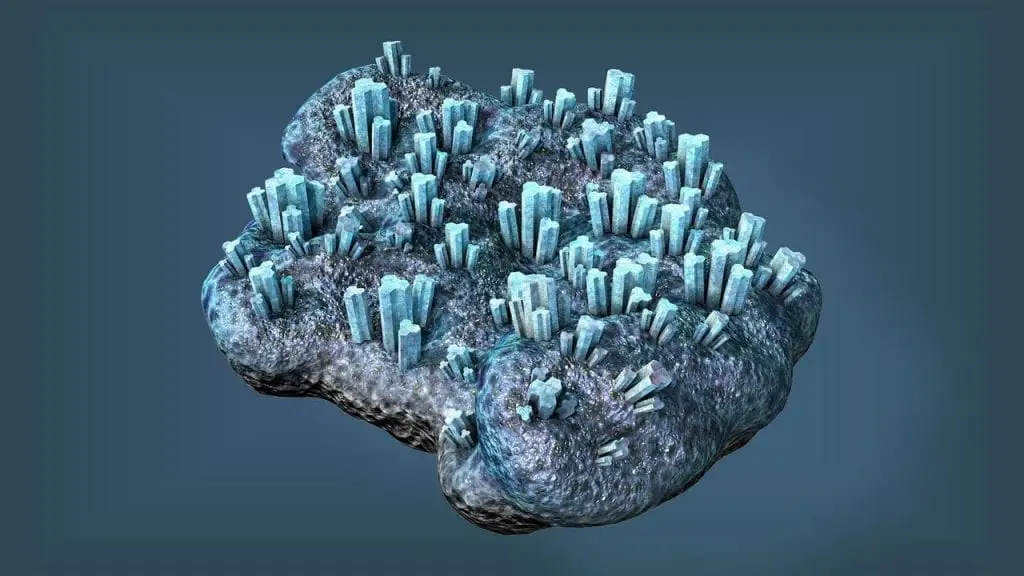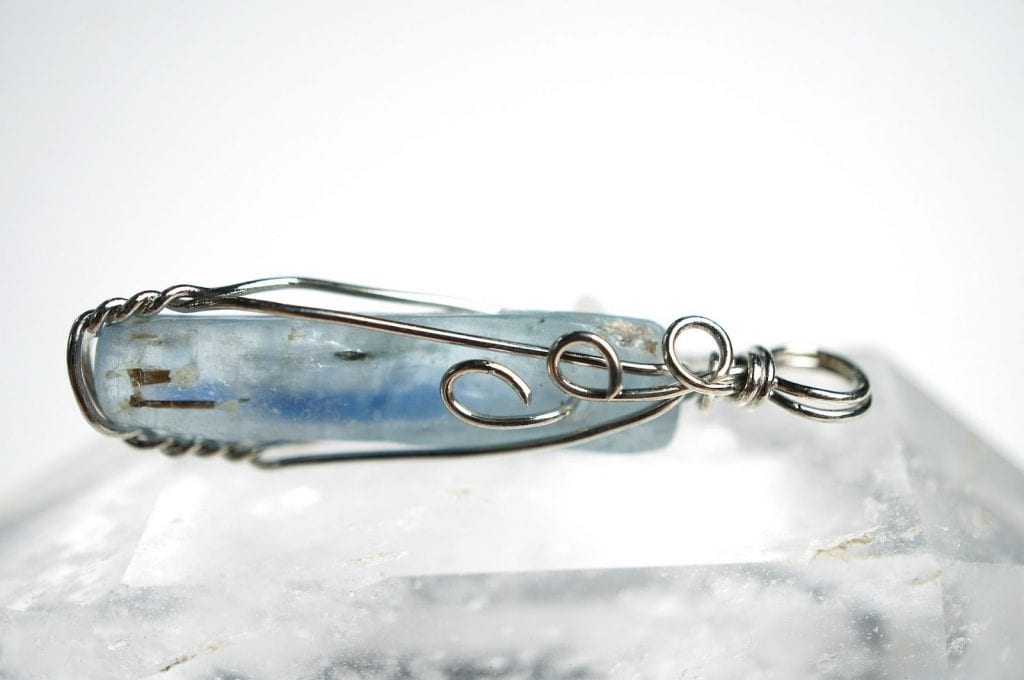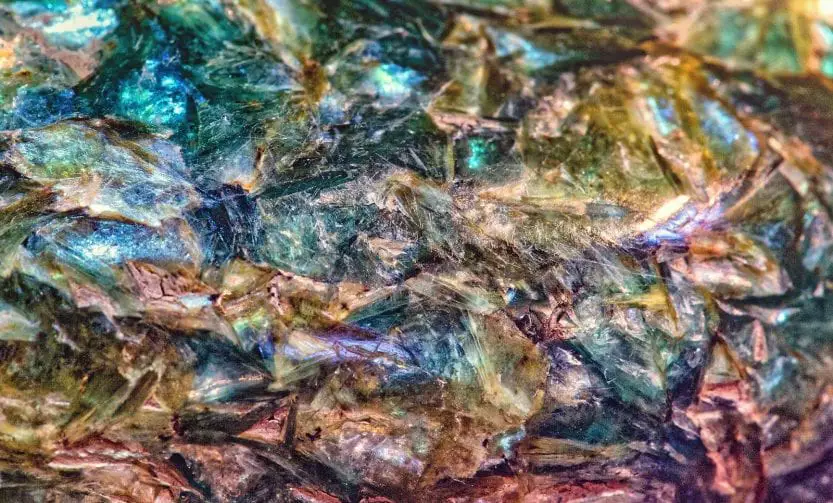Name and classification of the kyanite mineral
Kyanite is one of the polymorphs of the aluminum silicate (Al2OSiO4) mineral. Its name comes from ‘kyanos’ or ‘kuanos’. This Greek word means ‘deep blue’, and refers to the most common color in which this mineral is formed. This name was given in 1789 by the German mineralogist and geologist Abraham Gottlob Werner. Before Werner’s crystal classification, kyanite was known under many names —blue talc, lamellar/laminated beryl, sappare, sapparite and munkrudite. During the nineteenth and the early twentieth century, French geologists adopted Werner’s classification, and used an alternative spelling, cyanite. Kyanite is also known under the name disthene. Due to its color similarity with sapphire, kyanite has also been called ‘the sapphire of the poor man’.
Kyanite — a blade crystal formed at the time of continental collisions
Kyanite forms during metamorphosis of clay-rich sedimentary rocks and metamorphic pegmatites, under medium to high pressures and low to moderate temperatures. Kyanite was formed during continent-continent collisions which resulted in the formation of the super-continent Pangaea. As a result, kyanite is commonly found in mountainous areas.
Kyanite mineral typically develops in the form of elongated blades (rectangular blade crystal or subhedral blade-like prisms), in gneisses and schists. Gneisses are a type of coarse-grained metamorphic rock with a banded structure. Schists are a class of medium-grade metamorphic rocks whose mineral grains have parallel orientation. The crystal blades are often large and well-formed, which makes them popular among crystal collectors, gemologists and jewelers.
Less commonly, kyanite can be found in quartzite (a hardened, metamorphic rock composed of quartz) and eclogite (a dense metamorphic rock formed from magic igneous rock). Kyanite is also found in igneous rocks, such as granite. It is often accompanied by other minerals, such as garnet, mica, staurolite, andalusite, talc, hornblende, gedrite and corundum.
Kyanite sometimes occurs in masses of crystals, radiating in veins. Very rarely, this brittle mineral can be found in flattened tabular crystals, and even as a part of V-shaped crystal twins.

Anisotropic kyanite — a crystal with two strengths
One of the alternative names of kyanite is disthene, or ‘two strengths’ (from the Greek ‘di’, meaning ‘two’, and ‘destenos’, meaning “force”). The name reflects the anisotropic character of the crystal. The mineral’s hardness can vary, based on the crystallographic direction. When measured longitudinally (along the blade), the hardness of on the Mohs scale of crystal hardness is 4.5-5. When measured across the perpendicular orientation, the hardness is 6.5-7.
The color formation in kyanite
The color of kyanite can be gray-green, various hues of blue (light to dark to indigo), black, white or even colorless. Very rarely, kyanite can be yellow, orange or pink. The most common colors are blue and blue-gray. Often, within a single crystal, multiple shades can be present in zones, blotches and color stripes.
The light blue color of kyanite specimens found in kimberlites (igneous rock often found in the Kimberley Mines of South Africa) is due to traces of chromium. The blue color in metamorphic kyanite results from trace amounts of Fe2+ and Ti+4 impurities. The orange-color kyanite from Tanzania owes its color to the presence of manganese in the rock structure. A rare, teal color kyanite found in Orissa, India, is called chromium kyanite, due to a high content of chromium.
Kyanite is a mineral with uneven color distribution. It is almost never free from inclusions and flaws. Therefore, kyanite is rarely translucent. The transparent kyanite specimens are most desirable and highly prized. Some cabochon-cut kyanite samples display chatoyancy (optical ‘cat’s eye’ phenomenon).
Geographical distribution of kyanite deposits
Kyanite is a common mineral, found worldwide. Important kyanite locations are Myanmar (Burma), Cambodia, India, Nepal, Kenya, Zimbabwe, Tanzania, USA, Canada, Austria, Serbia, France, Italy and Brazil.
The world’s largest producers and exporters of kyanite are India, South Africa, United States and France. Due to overexploitation which began in the 1960’s, the Lapsa Buru mines in Kharswan, India, once largest deposit of kyanite the world, are now completely exhausted. In spite of intensive mining, India still has the largest deposits of kyanite in the world.
There are several notable locations around the world, where high-quality and unique kyanite has been found. For example, the Masaku mines in Kenya are known for their colorless kyanite. Transparent blue-color kyanite has been found in Nepal. Kyanite with staurolite have been found in the Central St. Gotthard Massif of Switzerland. Large orange, V-shaped kyanite twins, have been found in the Arusha region of Tanzania. The Russian Chelyabinsk Oblast is known for its kyanite in matrix crystal deposits. Gemmy (very transparent) kyanite crystals with a notable blue central vein were discovered in Bahia, Brazil.

The polymorphic triad — kyanite, andalusite and sillimanite
Kyanite is not the only aluminum silicate mineral with the chemical formula Al2OSiO4. Kyanite, andalusite and sillimanite are polymorphs minerals with same chemical composition, but different crystal structures and physical properties. The three polymorphs are sometimes called ‘sillimanite group’.
In terms of crystal structure, andalusite and sillimanite are orthorhombic crystals, while kyanite forms as triclinic crystals.
The three minerals formed under a different combination of pressure and temperature exposure. Andalusite formed under low pressure and low-to-high temperatures. Sillimanite formed at high temperature and under variable pressure. Kyanite formed under high pressure and low to moderate temperatures. Due to the highest pressure conditions during its formation, kyanite is densest is this polymorphic group of minerals.
Kyanite was once used as a compass
Centuries ago, ancient travelers used kyanite as a compass. They believed that the crystal follows the earth’s magnetic force, and can therefore help them in orientation. Crystallographers have reported that kyanite can sometimes exhibit magnetic properties, when it contains traces of iron and chromium.
Followers of the New Age movement consider the blue kyanite a powerful crystal. It is believed that the famous sword of Archangel Michael was made of kyanite. This is considered a high-vibration crystal. Kyanite is used in crystal healing, Kundalini yoga (for chakra alignment) and in the practice of astral projection.



